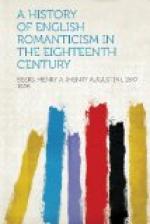“To teach the young idea how to shoot.”
“Winter” was followed by “Summer” in 1727, “Spring” in 1728, and the completed “Seasons” in 1730. Thomson made many changes and additions in subsequent editions. The original “Seasons” contained only 3902 lines (exclusive of the “Hymn"), while the author’s final revision of 1746 gave 5413. One proof that “The Seasons” was the work of a fresh and independent genius is afforded by the many imitations to which it soon gave birth. In Germany, a passage from Brockes’ translation (1745) was set to music by Haydn. J. P. Uz (1742) and Wieland each produced a “Fruehling,” in Thomson’s manner; but the most distinguished of his German disciples was Ewald Christian von Kleist, whose “Fruhling” (1749) was a description of a country walk in spring, in 460 hexameter lines, accompanied, as in Thomson’s “Hymn,” with a kind of “Gloria in excelsis,” to the creator of nature. “The Seasons” was translated into French by Madame Bontemps in 1759, and called forth, among other imitations, “Les Saisons” of Saint Lambert, 1769 (revised and extended in 1771.) In England, Thomson’s influence naturally manifested itself less in direct imitations of the scheme of his poem than in the contagion of his manner, which pervades the work of many succeeding poets, such as Akenside, Armstrong, Dyer, Somerville and Mallet. “There was hardly one verse writer of any eminence,” says Gosse,[5] “from 1725-50, who was not in some manner guided or biased by Thomson, whose genius is to this day fertile in English literature.”
We have grown so accustomed to a more intimate treatment and a more spiritual interpretation of nature, that we are perhaps too apt to undervalue Thomson’s simple descriptive or pictorial method. Compared with Wordsworth’s mysticism, with Shelley’s passionate pantheism, with Byron’s romantic gloom in presence of the mountains and the sea, with Keats’ joyous re-creation of mythology, with Thoreau’s Indian-like approach to the innermost arcana—with a dozen other moods familiar to the modern mind—it seems to us unimaginative. Thomson has been likened, as a colorist, to Rubens; and possibly the glow, the breadth, and the vital energy of his best passages, as of Rubens’ great canvases, leave our finer perceptions untouched, and we ask for something more esoteric, more intense. Still there are permanent and solid qualities in Thomson’s landscape art, which can give delight even now to an unspoiled taste. To a reader of his own generation, “The Seasons” must have come as the revelation of a fresh world of beauty. Such passages as those which describe the first spring showers, the thunderstorm in summer, the trout-fishing, the sheep-washing, and the terrors of the winter night, were not only strange to the public of that day, but were new in English poetry.
That the poet was something of a naturalist, who wrote lovingly and with his “eye upon the object,” is evident from a hundred touches, like “auriculas with shining meal”;




